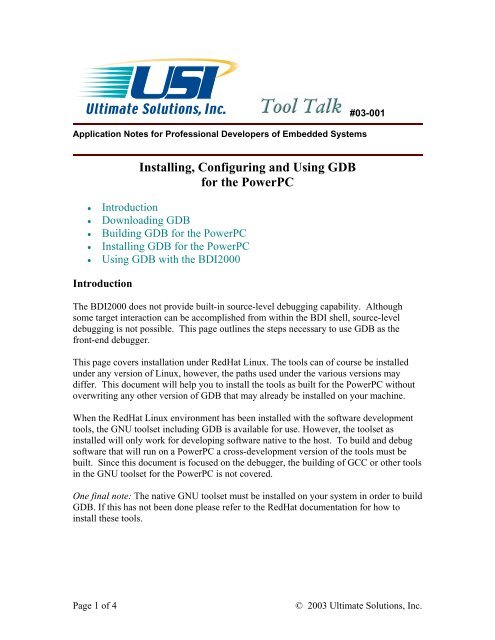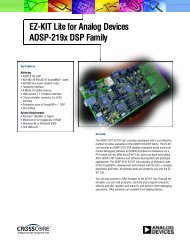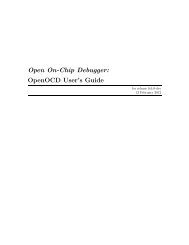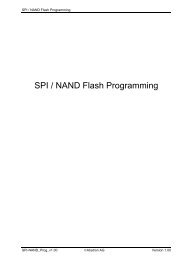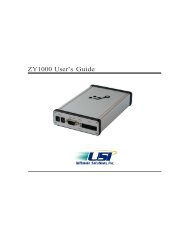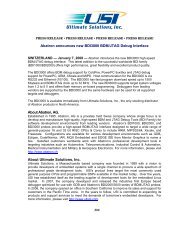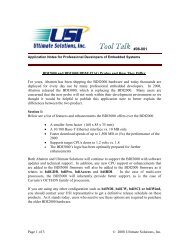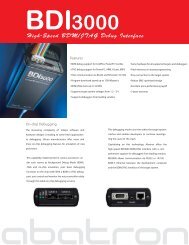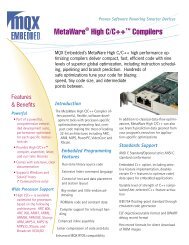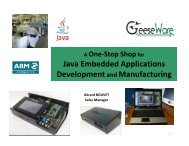Configuring & Using GDB with the PowerPC - Ultimate Solutions
Configuring & Using GDB with the PowerPC - Ultimate Solutions
Configuring & Using GDB with the PowerPC - Ultimate Solutions
- No tags were found...
Create successful ePaper yourself
Turn your PDF publications into a flip-book with our unique Google optimized e-Paper software.
Application Notes for Professional Developers of Embedded Systems#03-001Installing, <strong>Configuring</strong> and <strong>Using</strong> <strong>GDB</strong>for <strong>the</strong> <strong>PowerPC</strong>IntroductionDownloading <strong>GDB</strong>Building <strong>GDB</strong> for <strong>the</strong> <strong>PowerPC</strong>Installing <strong>GDB</strong> for <strong>the</strong> <strong>PowerPC</strong><strong>Using</strong> <strong>GDB</strong> <strong>with</strong> <strong>the</strong> BDI2000IntroductionThe BDI2000 does not provide built-in source-level debugging capability. Althoughsome target interaction can be accomplished from <strong>with</strong>in <strong>the</strong> BDI shell, source-leveldebugging is not possible. This page outlines <strong>the</strong> steps necessary to use <strong>GDB</strong> as <strong>the</strong>front-end debugger.This page covers installation under RedHat Linux. The tools can of course be installedunder any version of Linux, however, <strong>the</strong> paths used under <strong>the</strong> various versions maydiffer. This document will help you to install <strong>the</strong> tools as built for <strong>the</strong> <strong>PowerPC</strong> <strong>with</strong>outoverwriting any o<strong>the</strong>r version of <strong>GDB</strong> that may already be installed on your machine.When <strong>the</strong> RedHat Linux environment has been installed <strong>with</strong> <strong>the</strong> software developmenttools, <strong>the</strong> GNU toolset including <strong>GDB</strong> is available for use. However, <strong>the</strong> toolset asinstalled will only work for developing software native to <strong>the</strong> host. To build and debugsoftware that will run on a <strong>PowerPC</strong> a cross-development version of <strong>the</strong> tools must bebuilt. Since this document is focused on <strong>the</strong> debugger, <strong>the</strong> building of GCC or o<strong>the</strong>r toolsin <strong>the</strong> GNU toolset for <strong>the</strong> <strong>PowerPC</strong> is not covered.One final note: The native GNU toolset must be installed on your system in order to build<strong>GDB</strong>. If this has not been done please refer to <strong>the</strong> RedHat documentation for how toinstall <strong>the</strong>se tools.Page 1 of 4© 2003 <strong>Ultimate</strong> <strong>Solutions</strong>, Inc.
Downloading <strong>GDB</strong>The first step to building <strong>GDB</strong> for <strong>PowerPC</strong> is to download <strong>the</strong> <strong>GDB</strong> software. The <strong>GDB</strong>Home Page is <strong>the</strong> best place to start in finding <strong>the</strong> software and suggests mirror site fromwhich it can be downloaded. The following is a suggested sequence to follow indownloading and unpacking <strong>the</strong> software:1. Make a directory to download <strong>the</strong> software to> mkdir gdbtools2. From <strong>the</strong> <strong>GDB</strong> download page download <strong>the</strong> file gdb-.tar.gz to <strong>the</strong>new directory3. Unpack <strong>the</strong> tools using <strong>the</strong> following command> tar zxvf gdb-.tar.gzThe directory now contains <strong>the</strong> downloaded file as well as a directory titled gdb-Building <strong>GDB</strong> for <strong>the</strong> <strong>PowerPC</strong>Although you can build <strong>GDB</strong> <strong>with</strong>in <strong>the</strong> gdb- directory tree, it isrecommended that <strong>the</strong> <strong>PowerPC</strong> version be built in a separate directory. This approachallows you to build <strong>GDB</strong> versions for o<strong>the</strong>r target types that may be used in <strong>the</strong> future.Building <strong>GDB</strong> is a 2-step process: configuration and build. The following is a suggestedsequence to configure and build <strong>the</strong> software. From <strong>the</strong> gdbtools directory perform <strong>the</strong>following steps:1. Make a directory in which to build gdb and cd into <strong>the</strong> directory :> mkdir gdb-powerpc-linux> cd gdb-powerpc-linux2. Run <strong>the</strong> configuration tool specifying <strong>PowerPC</strong> as <strong>the</strong> target-type:> ../gdb-/configure --target=powerpc-linux3. Now build <strong>GDB</strong>. Note that this will take several minutes:> makePage 2 of 4© 2003 <strong>Ultimate</strong> <strong>Solutions</strong>, Inc.
Installing <strong>GDB</strong> for <strong>the</strong> <strong>PowerPC</strong>You can install <strong>the</strong> cross-<strong>GDB</strong> in a variety of places. The default location is/usr/local/bin. This location works fine since <strong>the</strong> location for <strong>the</strong> native <strong>GDB</strong> in mostLinux environments is /usr/bin. You simply reorder your PATH statement in your loginscripts, depending on which version you want to use. The cross-<strong>GDB</strong> can also beinstalled in your local account, or virtually any place you want to install it. You canspecify <strong>the</strong> location when performing <strong>the</strong> configuration mentioned above simply byadding <strong>the</strong> --prefix= option to <strong>the</strong> configure line. To install <strong>GDB</strong> simplytype <strong>the</strong> following command:> make install<strong>Using</strong> <strong>GDB</strong> <strong>with</strong> <strong>the</strong> BDI2000Firmware DebuggingThe following are some basic steps to get you started using <strong>GDB</strong> to debug firmware thathas been programmed into flash. Use <strong>the</strong> help command in <strong>GDB</strong> to find a list of allavailable commands:1. Open two console windows2. In console window 1- Open a telnet session to <strong>the</strong> BDI- Reset <strong>the</strong> target boardBDI> reset- Set <strong>the</strong> PC to <strong>the</strong> reset vectorBDI> rm pc 3. In console window 2- Change to <strong>the</strong> directory where <strong>the</strong> firmware image was built- Run <strong>GDB</strong> specifying <strong>the</strong> name of <strong>the</strong> ELF file associated <strong>with</strong> <strong>the</strong> firmwareimage- At <strong>the</strong> <strong>GDB</strong> prompt connect to <strong>the</strong> target(gdb) target remote :2001- Set appropriate breakpoints.- Start running <strong>the</strong> firmware(gdb) continueNote: <strong>the</strong> continue command, ra<strong>the</strong>r than <strong>the</strong> run command, must be use to run <strong>the</strong>program.Page 3 of 4© 2003 <strong>Ultimate</strong> <strong>Solutions</strong>, Inc.
Application DebuggingTBDGUI Front-ends for <strong>GDB</strong>GUI front-ends make using <strong>GDB</strong> easier because <strong>the</strong>y provide immediate visual feedbackduring <strong>the</strong> debugging process. Several front-ends are available. The following is a list ofsome of <strong>the</strong> more popular ones. Follow <strong>the</strong> associated links to find out more about each:DDDInsightAuthored by:Dan Jozwiak - Independent ContractorMapleLeaf Software, Inc.1 Heritage CircleHudson, NH 03051(603) 566-0919<strong>Ultimate</strong> <strong>Solutions</strong>, Inc.10 Clever LaneTewksbury, MA 01876Toll Free: 866.455.3383 Phone: 978.455.3383Fax: 978.926.3091 Email: info@ultsol.comWeb: http://www.ultsol.comPage 4 of 4© 2003 <strong>Ultimate</strong> <strong>Solutions</strong>, Inc.


